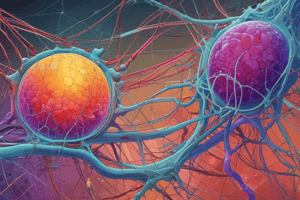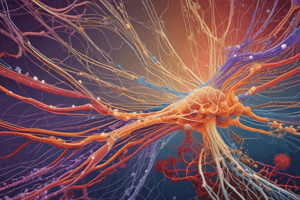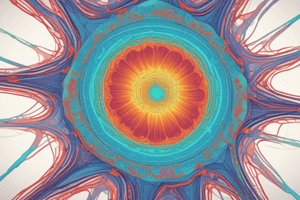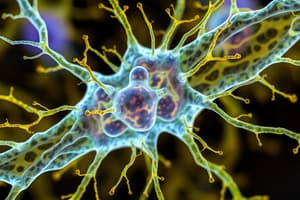Podcast
Questions and Answers
Which protein converts chemical energy in ATP into mechanical work?
Which protein converts chemical energy in ATP into mechanical work?
- Dynein
- Flagellin
- Kinesin (correct)
- Tubulin
What is the role of microtubules in vesicle transport?
What is the role of microtubules in vesicle transport?
- Make up the flagella
- Provide stability
- Convert ATP into mechanical work
- Act as 'railroad tracks' (correct)
What is the name of the microtubule organizing center in animal cells?
What is the name of the microtubule organizing center in animal cells?
- Dynein
- Centriole
- Cilium
- Centrosome (correct)
What is the function of centrioles in the centrosome?
What is the function of centrioles in the centrosome?
What is the structure of bacterial flagella made of?
What is the structure of bacterial flagella made of?
How do eukaryotic flagella move?
How do eukaryotic flagella move?
What is the function of cilia?
What is the function of cilia?
What powers the movement of dynein arms in flagella and cilia?
What powers the movement of dynein arms in flagella and cilia?
What is the name of the protein that makes up microtubules?
What is the name of the protein that makes up microtubules?
What is the role of microtubules in organelles?
What is the role of microtubules in organelles?
Which type of cytoskeletal element is involved in movement by interacting with the motor protein myosin?
Which type of cytoskeletal element is involved in movement by interacting with the motor protein myosin?
What is the main function of intermediate filaments?
What is the main function of intermediate filaments?
Which cytoskeletal element helps define the cell's shape by forming long bundles or dense networks just inside the plasma membrane?
Which cytoskeletal element helps define the cell's shape by forming long bundles or dense networks just inside the plasma membrane?
What is the role of microtubules in the cytoskeleton?
What is the role of microtubules in the cytoskeleton?
Which type of cytoskeletal element is not involved in movement?
Which type of cytoskeletal element is not involved in movement?
What is the main function of the cytoskeleton?
What is the main function of the cytoskeleton?
Which type of cytoskeletal element is the smallest?
Which type of cytoskeletal element is the smallest?
What type of interaction can cause cell movements such as cell crawling and cytokinesis?
What type of interaction can cause cell movements such as cell crawling and cytokinesis?
Which type of cytoskeletal element is involved in intracellular anchoring?
Which type of cytoskeletal element is involved in intracellular anchoring?
What is the dynamic nature of the cytoskeleton?
What is the dynamic nature of the cytoskeleton?
Flashcards are hidden until you start studying
Study Notes
Motor Proteins and Movement
- Dynein converts chemical energy in ATP into mechanical work, powering the movement of flagella and cilia.
- Myosin interacts with actin filaments, enabling movement such as cell crawling and cytokinesis.
Microtubules and Vesicle Transport
- Microtubules play a crucial role in vesicle transport, guiding vesicles to their destinations.
- The microtubule organizing center (MTOC) in animal cells is the centrosome.
- Centrioles within the centrosome function to organize microtubules.
- Microtubules are composed of the protein tubulin.
Microtubule Functions
- Microtubules provide structural support to organelles, helping to maintain their shape and position.
- They also play a vital role in the cytoskeleton, contributing to the overall shape and organization of the cell.
Cilia and Flagella
- Cilia are involved in movement, sensing, and signaling, and are powered by the protein dynein.
- Bacterial flagella are composed of the protein flagellin.
- Eukaryotic flagella move through the coordinated bending of microtubules, driven by the movement of dynein arms.
Intermediate Filaments
- Intermediate filaments are involved in maintaining the cell's shape by forming long bundles or dense networks just inside the plasma membrane.
- Their main function is to provide mechanical support and stability to the cell.
Cytoskeleton
- The cytoskeleton is a dynamic system, constantly assembling and disassembling to facilitate cellular processes.
- Its main function is to provide shape, support, and movement to the cell.
- Actin filaments are the smallest type of cytoskeletal element.
- Intermediate filaments are not directly involved in movement.
- The cytoskeleton plays a crucial role in intracellular anchoring, enabling the attachment of organelles and other cellular structures.
Studying That Suits You
Use AI to generate personalized quizzes and flashcards to suit your learning preferences.




